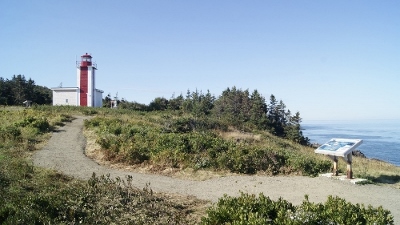Prim Point Lighthouse
Heritage Lighthouse
Digby, Nova Scotia

General view
© Robert Hersey
Address :
Lighthouse Road, Prim Point, Digby, Nova Scotia
Recognition Statute:
Heritage Lighthouse Protection Act (S.C. 2008, c 16)
Designation Date:
2015-02-12
Dates:
-
1964 to 1964
(Construction)
-
1817 to 1817
(Established)
Description of Historic Place
The Prim Point Lighthouse is a 13.9 metres (46 feet) tall reinforced-concrete tower with an attached fog alarm building. Built in 1964, it is the third tower on this site to mark the narrow passage at Digby Gut. It sits in a wooded area overlooking the rocky cliffs on the west point of Digby Gut at the narrow opening of the Annapolis Basin in the Bay of Fundy.
Heritage Value
The Prim Point Lighthouse is a heritage lighthouse because of its historical, architectural, and community values.
Historical values
The Prim Point Lighthouse is an excellent example of the system of aids to navigation along Nova Scotia’s coastline. For two centuries, there has been a light at Prim Point to guide mariners from the Bay of Fundy to the Annapolis Basin. As the third lighthouse on the site, it reflects the evolution of the government’s approach in the 1950s and 1960s to build automated and unstaffed lighthouses. The lighthouse is also associated with numerous shipwrecks such as the SS Princess Louise and the steamers Westport and Agnes G. Donahue, which involved lifesaving.
The Prim Point Lighthouse played a key role as a local aid to navigation for nearly two centuries as it continuously supported the economic development of the small coastal community of Digby, whose main economic activities revolve around the fishing, shipping, lumbering, and tourism industries.
Architectural values
The Prim Point Lighthouse is a very good example of a square reinforced-concrete tower combined with a fog alarm building. It reflects the utilitarian style of lighthouses built in the 1950s and 1960s along Canada’s coastline.
The Prim Point Lighthouse features an efficient design of a combined tower and fog alarm building. The lighthouse is in fairly good condition, a tribute to the quality of the materials used and its craftsmanship.
Community values
Located atop a rocky cliff-face, Prim Point Lighthouse is the only structure visible from the water and thus reinforces the maritime character of the rugged coastline of Digby Gut. The light station has also become part of the soundscape of Digby with its fog alarm that can be heard 9 km away from the town’s centre.
Prim Point Lighthouse is highly valued in the community as an important tourist attraction in the area. The small maritime community of Digby takes pride in the maintenance and promotion of the lighthouse. Thanks to its proximity to the Bay of Fundy, the lighthouse is known to local residents and tourists to be the best place to experience the bay’s world-renowned dramatic tide changes.
Related buildings
No related building.
Character-Defining Elements
The following character-defining elements of the Prim Point Lighthouse should be respected:
— its location overlooking rocky cliffs in a wooded area;
— its intact, as-built structural form, height, profile, and balanced proportions;
— its square reinforced-concrete tower attached to the single-storey concrete block fog alarm building;
— its gallery with a metal railing surrounding the hexagonal metal lantern;
— the door and two small windows of the fog alarm building;
— its traditional red and white exterior colour scheme: the white tower with a vertical red stripe on its side as well as the red lantern and gallery railing;
— its visual prominence in relation to the water, cliffs, and landscape.